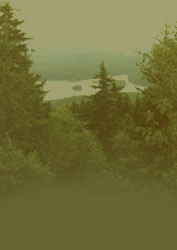|
Do you have something
happening in your corner of Washington? - Please call a member
or e-mail your observations to have them included here
November:
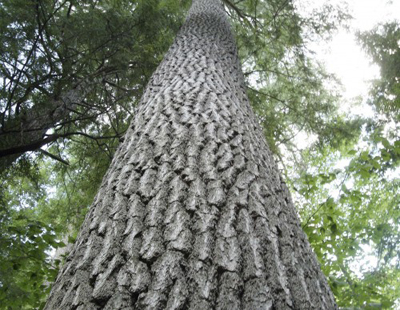
Picture of a big pine tree in Bradford NH by AP
Hunting For NH's Big Trees
Do you know New Hampshire is home to seven national champion “Big Trees?” These are the largest examples of their species discovered nationwide. New Hampshire hosts the largest black locust, mountain-ash, pitch pine, eastern white pine, black spruce, staghorn sumac and black birch in the entire US. They’re among 760 champion trees documented by The NH Big Tree Program.
A recent American Forests magazine featured NH's Big Tree program and highlighted efforts by dedicated volunteers searching for the biggest trees in the state.
Concord hosts several giants including the State champion American Sycamore prominently located at the Kimball-Jenkins estate. A walking tour of "The Big Trees of Concord" includes several stately shade trees located in leafy neighborhoods of the State capital.
NH's big trees are not yet a big tourism magnet. But for volunteers, finding, measuring and reporting the locations of big trees becomes an obsession. Tree scores by species use a unique point system based on the sum of the height, circumference of the trunk and an estimate of the average crown spread to create a combined score - for an "apples to apples" comparison!
More on New Hampshire's big trees:
The NH Big Tree database
The story in American Forests magazine
Story found at: NPR - Something Wild by Dave Anderson
October:

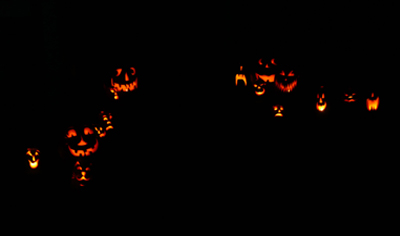
pictures by Jed Schwartz
Time to carve your Pumpkins into Jack-O'-Lanterns!
The name "jack-o'-lantern" is of British origin and dates from the 17th century, when it literally meant "man with a lantern" (i.e., a night watchman). It was also a nickname for the natural phenomenon known as ignis fatuus (fool's fire) or "will o' the wisp," the mysterious, flickering lights sometimes seen at night over wetlands and associated in folklore with fairies and ghosts playing pranks on travelers.
Over time "jack-o'-lantern" became the popular term for a homemade object also known as a "turnip lantern," defined by Thomas Darlington in his 1887 volume The Folk-Speech of South Cheshire as "a lantern made by scooping out the inside of a turnip, carving the shell into a rude representation of the human face, and placing a lighted candle inside it."
In some parts of Great Britain carrying turnip lanterns was regarded as a form of pranksterism. Darlington writes: "It is a common device of mischievous lads for frightening belated wayfarers on the road." For Catholic children it was customary to carry jack-o'-lanterns door-to-door to represent the souls of the dead while begging for soul cakes on Hallowmas (All Saints Day, Nov. 1) and All Souls Day (Nov. 2). They were also carried by parading celebrants on the night of Guy Fawkes Day (Nov. 5).
There is also the story of "Stingy Jack" but we'll save that one for another day!
It wasn't until Irish immigrants brought the custom of carving jack-o'-lanterns to North America that the more commonly available pumpkin came to be used for that purpose, and not until the mid-to-late 19th century that pumpkin carving became a Halloween staple across the United States.
Now it is a Halloween tradition that some take very seriously!!
Article found at: Urban Legends - Halloween, By David Emery
September:
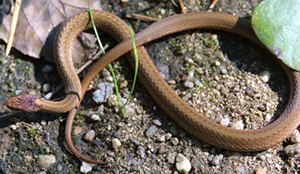
picture by Victor Young
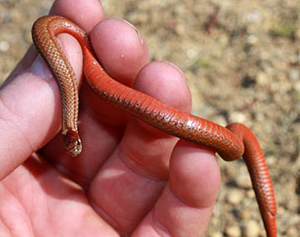
picture by Mike Marchand
Worm Snake?
After Johanna reported she thought she might have seen a Worm Snake near her woodpile, Arin asked Mike Marchand of NH Fish and Game about the occurrence of a Worm Snakes in NH. He said there are no worm snake records for NH, they are native to Massachusetts but VERY rare there as well (maybe one record). He thought it was likely a Ringneck, Brown or Redbelly snake.
From her description it was probably a Northern Redbellied snake. They are a small snake measuring about 8 to 10 inches with a brown or gray body surface and a plain red belly. They are found in a variety of areas including moist or dry woodlands, upland fields, shorelines, swamps, and sphagnum bogs. Redbelly snakes use a variety of cover objects including woody debris, rocks, and human trash and debris piles. They eat mostly slugs and snails. They give birth to live young during late summer and fall and hibernate underground in holes or abandoned anthills in the winter.
There are 11 species of snakes that are native to New Hampshire. Some of these species, like the garter snake, are common and widespread across the state. Other species, like the timber rattlesnake, are extremely rare and are now state protected.
New Hampshire Fish & Game maintains a database of all reptile and amphibian reports through its Reptile and Amphibian Reporting Program (RAARP). More information about this program here: F&G RAARP
New Hampshire's 11 species of snakes are these:
Garter snake (Thamnophis sirtalis)
Ribbon snake (Thamnophis sauritus)
Brown snake (Storeria dekayi dekayi)
Northern red-bellied snake (Storeria occipitomaculata occipitomaculata)
Ringneck snake (Diadophis punctatus edwardsii)
Smooth green snake (Opheodrys vernalis)
Milk snake(Lampropeltis triangulum triangulum)
Eastern hognose snake (Heterodon platirhinos) – State Endangered
Northern black racer (Coluber constrictor constrictor) - State Threatened
Northern water snake (Nerodia sipedon sipedon)
Timber rattlesnake (Crotalus horridus) – State Endangered
PLEASE DO NOT KILL SNAKES! NH has only one venomous snake, the timber rattlesnake, which is protected by law. If you think you see a timber rattlesnake, please leave it alone, and let NH Fish and Game know. There is no reason to kill a NH snake.
Information found at: NH Fish & Game - Snakes
July:

picture by Mike Baird/Flickr
When gazing out over a pond, a slight movement along the wooded edge can catch your eye. You may see a Great Blue Heron, slowly lifting one of its long legs as it stalks its prey. The dagger-like bill is poised to spear a frog or a fish. When fishing, the bird is silent.
This magnificent, lean gray bird stands about 4 feet tall. Whether it is a male or female, you can’t tell, because they look alike. It is the continent's largest heron species.
Herons are colony nesters, meaning that they nest together in groups. The noise they make is tremendous, like something out of a dinosaur movie with harsh and guttural “frahnk, frahnk” croaks echoing throughout the colony.
Great blue heron rookerys or nest areas tend to be in remote places often associated with beaver impoundments, with one to more than 50 nests. Occasionally, herons will nest on wooded islands in lakes, or even upland on ridges. They need to be in remote places because human activity can cause herons to abandon their nests.
In late March, great blue herons return to New Hampshire from all points. Males bring sticks to females, which arrange them in the nest. Old nests can become quite large, but new ones look pretty sparse.
Courtship includes neck stretching, crest raising, bill clapping and feather nibbling. Mating occurs on or near the nest. Other than during courtship and when young are on the nest, the birds are quiet.
Herons lay eggs from mid-April to early May, depending upon the weather. Both males and females incubate the three to five eggs. If the weather is cold and rainy in May and June, nests may fail to produce young. If the clutch fails early in the season, a heron may lay a new set of eggs.
Young herons hatch after 28 days, and both parents are kept busy feeding the young. When the birds are small, one parent will guard the nest and the other will feed, sometimes from great distances away. Herons first feed their young herons by regurgitating their own food, and later switch to whole fish. As the nestling grows, both parents hunt for food.
By early July, the young herons are almost as big as adults and look way too big for the nest.
Young herons stay in the nest for seven to eight weeks, and most have fledged by late July. The parents continue feeding them for two to three weeks after they leave the nest.
Once parents stop feeding the young, the herons disperse in all directions, starting in mid- September and through October. Occasionally, great blue herons may spend the winter near New Hampshire’s seacoast.
While vocal in flight, the bird takes to the sky with slow, deep wingbeats, its long neck curved into an S-shape, and its head hunched back upon its shoulders. It is quite a sight to behold!
There is a historical report of a Heron rookery in Washington, let us know if you have come across it!
Information found at: NH Fish & Game Wildlife Journal
and: NH Audubon
June:
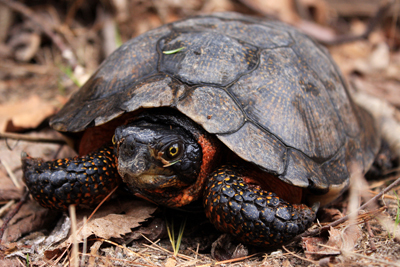
picture by Mike Jones
Jed came upon a Wood turtle while working on a trail.
Wood turtles are found in slow-moving streams and channels with sandy bottoms. They make extensive use of terrestrial habitats during summer, venturing into fields, meadows, woodlands, scrubland and floodplain areas, as well as wetlands.
They are a species of "special concern" and a Wildlife Action Plan "species in greatest need of conservation". They are legally protected in New Hampshire and possession, sale, import, and taking (harm, harass, injuring, killing) is illegal.
It is a 5-8 inch turtle characterized by its highly sculpted shell where each large scute takes on an irregular pyramidal shape. The neck and forelimbs are orange and the lower shell or plastron has distinct dark spotted markings.
Nest sites are usually near streams but may also be in clearings, agricultural fields, or other disturbed areas. They hibernate in winter in slow-moving streams and rivers under riverbanks, root masses, or woody debris.
Did you know that the New Hampshire Fish and Game Department maintains a database of all reptile and amphibian reports through its Reptile and Amphibian Reporting Program (RAARP)?
The "RAARP" program is coordinated by the NH Fish and Game Nongame & Endangered Wildlife Program and gives volunteers a place to report sightings of reptiles and amphibians from spring peepers to snapping turtles. These reports are extremely valuable to biologists.
Observations are used to determine the distribution of all reptiles and amphibians within New Hampshire. Reports of less common species are very important. Verified reports of rare species locations are mapped and stored in a database used for land protection and conservation purposes. Reports should be accompanied by a clear photograph whenever possible.
If you spot an interesting turtle, snake, salamander or frog, NH Fish & Game wants to know! To learn more about reptile and amphibians in New Hampshire click here: NH Fish & Game - reptiles and amphibians
Information found at: NH Fish & Game
May:
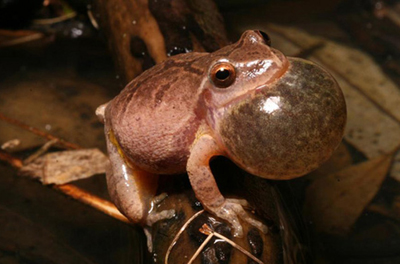
picture by Nature Conservancy
Spring peepers are to the amphibian world what American robins are to the bird world. As their name implies, they begin emitting their familiar sleigh-bell-like chorus right around the beginning of spring.
Found in wooded areas and grassy lowlands near ponds and swamps in the central and eastern parts of Canada and the United States, these tiny, well-camouflaged amphibians are rarely seen. But the mid-March crescendo of nighttime whistles from amorous males is for many a sign that winter is over.
As their common name implies, the spring peeper has a high-pitched call similar to that of a young chicken, only much louder and rising slightly in tone. They are heard early in spring not long after the ice melts on the wetlands. The males usually call from the edges of the bodies of water in which they breed, hidden near the bases of shrubs or grasses.
Spring peepers are tan or brown in color with dark lines that form a telltale X on their backs. They grow to about 1 to 1.5 inches in length, and have large toe pads for climbing, although they are more at home amid the loose debris of the forest floor.
They are nocturnal creatures, hiding from their many predators during the day and emerging at night to feed on such delicacies as beetles, ants, flies, and spiders.
They mate and lay their eggs in water and spend the rest of the year in the forest. The spring peeper produces glucose, or sugar, and "freezes" itself for the winter. In winter, peepers' bodies freeze--but their cells don't rupture because of the concentrated sugars in them. These sugars act as a kind of natural anti-freeze. In the winter, they hibernate under logs or behind loose bark on trees, waiting for the spring thaw and their chance to sing.
Information found at: National Geographic
and: Wikipedia
April:
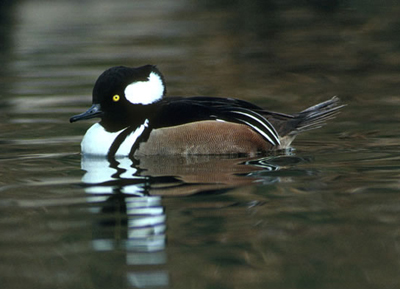
picture by US Fish and Wildlife
Here is what Jed saw in East Washington's Mill Pond recently, a Hooded Merganser! What caught his eye was the odd crest on its head and the way it dove completely underwater looking for food.
A quiet, secretive duck, the Hooded Merganser is the smallest of the North American mergansers, about the same size as the Wood Duck.
The hooded merganser is a small diving duck with a long, pointed black bill. The adult male hooded merganser has a white fan-shaped crest on its head. It has bright yellow eyes, a black head, a white chest with two black stripes, a brownish-black back, rust-colored sides and a grayish-brown rump and tail. The female hooded merganser has brown eyes, a reddish crest, and grayish-brown feathers.
Hooded Mergansers are the only merganser that lives (breeds and winters) exclusively in North America. It winters near coasts from British Columbia south to California and from New England south to Florida and Texas.
The hooded merganser usually gathers in small groups of no more than 10 or 12. When they are startled, they will fly away. They are one of the fastest flying ducks.
They like quiet, shallow, clear-water pools that have sandy or cobblestoned bottoms. They prefer ponds that are near or surrounded by deciduous woods: river bottomlands, small forest pools, millponds, swamps, and beaver ponds.
True to its scientific name, which translates to "hooded diver," Hooded Mergansers are experts at diving and foraging underwater. Their legs are situated farther back on the body and this makes them awkward on land but expert divers and swimmers. They also have eyes well adapted to seeing underwater. The hooded merganser feeds during the day. It dives and forages on lake, river and pond bottoms for fish, frogs, tadpoles, crayfish and invertebrates such as aquatic insects, snails and other mollusks and small crustaceans. It also eats aquatic insects and some aquatic plants.
The female lays 6-12 eggs in a nest in a tree hole or in a log. They nest 10 to 20 ft (3 to 6 m) off the ground in hollow trees, hollow stumps, other natural cavities, and nest boxes. The nest is lined with whatever is in the hole including woodchips, leaves and other debris and then it is lined with down. The male leaves the female once incubation begins. The eggs hatch in about a month. The eggs usually hatch within four hours of each other. The ducklings are covered in down, mobile, and able to feed themselves. They remain in the nest for 24 hours where they are brooded by the female. The female then leaves the cavity, calls to her young using a soft, guttural vocalization, and leads her brood to a nearby pond that is rich in invertebrates and small fish. The young are able to dive, but first dives are shallow and brief. The female alone cares for the ducklings. After 70 days, the young can fly, and the female leaves them and prepares for fall migration.
Hooded Mergansers migrate in late fall, and they migrate singly, in pairs, or in small flocks. They migrate short to intermediate distances. Most individuals in the northern part of the breeding range move to the southern and coastal regions of the continent, wintering mainly on freshwater. Some winter as far north as the ice permits.
Information found at: Cornell Birds Information
and: NHPTV, Natureworks
March:
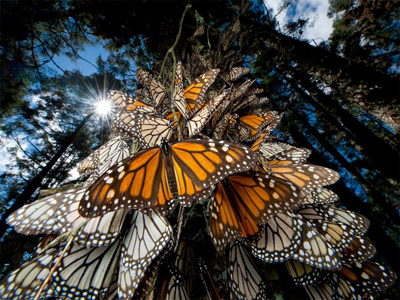
Monarch Butterflies picture by National Geographic
Monarch butterflies population fall to a record low!
Today the winter monarch colonies, which are found west of Mexico City, in an area of about 60 miles by 60 miles, are a pitiful remnant of their former splendor. Experts say the decline in the Monarch population now marks a statistical long-term trend and is no longer seen as a combination of yearly or seasonal events.
The total area covered by the colonies dwindled from an average of 22 acres between 1994 and 2003 to 12 acres between 2003 and 2012. This year’s area hit a record low of 2.9 acres. The numbers of the orange-and-black butterflies have crashed in the two decades since scientists began making a rough count of them, according to Mexico's National Commission of Natural Protected Areas.
Reasons for the decline are multiple, including: out-of-control ecotourism, extreme weather and diversion of water. Two threats loom above all others: the destruction of breeding habitat in the United States because of the widespread use of powerful herbicides and genetically engineered crops, and illegal logging in Mexico’s high-elevation Oyamel fir forests.
So what can be done? Ecotourism is an important part of the local mexican economy, but we must make sure that its costs in habitat degradation and increased butterfly mortality don’t kill the goose that lays the golden egg.
The Mexican government has made strides in reducing much, but not all, illegal logging, and needs to do more.
The United States, for its part, should re-examine the extent to which industrialized herbicide-based agriculture is destroying the flora in the Midwestern United States that monarchs depend on in the spring and summer. The farmland there once provided plenty of milkweed sprouting between rows of corn and soybean. But the heavy use of genetically modified, herbicide-tolerant crops has allowed farmers to wipe out milkweed and eliminate the monarchs' main food source. We've lost well over 120 million acres, and probably closer to 150 million acres. This must change!
We hope that better stewardship will allow the monarch butterflies to continue to festoon the Oyamel forests of Mexico for generations to come.
Information found at: New York Times
and:
NH Public Radio
February:
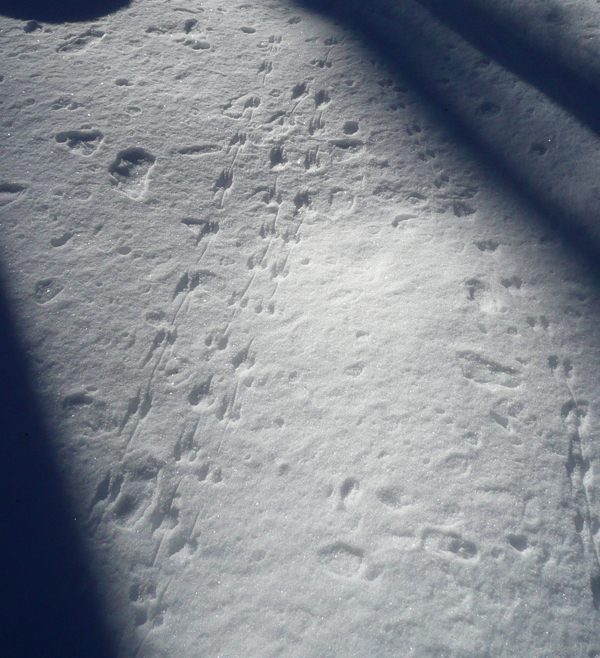
Tracks in the Snow
Winter is a great time to go out and see the stories written by animal tracks in the snow. There is a lot of animal activity in the winter, happening day and night. You may not see the animals but they leave their tracks as evidence of their activities.
By looking at their tracks you can see what they have been doing and where they were going. It is fun to visually gather the clues they leave and figure out their story.
If you are going out for a walk in the woods, have a animal track guide in your pocket to help read the tracks. Click here for one you can print out and keep in your pocket: Track Guide
Look for track and gait patterns, these will tell you how the animal walked.


There are four gaits that the animals use - making them either waddlers, walkers, bounders or gallopers. A good example of waddlers are wide bodied, slow moving animals such as bears, beavers and raccoons. Walkers are animals such as deer, moose, dogs and cats. Bounders include weasels, mink and fishers. Gallopers include mice, squirrels, and hares. Turkeys, grouse and crows are also walkers and their tracks look distinctively "bird-like".
Of course, an animal will make a different pattern if they are running after or from another animal. The size of the tracks will give you a clue to the size of the animal. The distance between tracks will give you a clue of how long the legs were. Look for tail drag. Is it a paw or hoof, how many toes does it have and does it have claws?
The condition of the snow, whether it is heavy and wet, fluffy powder or hard packed ice can also effect how the tracks will appear.
It's fun to put all the clues together and figure out "who goes there?"
January:
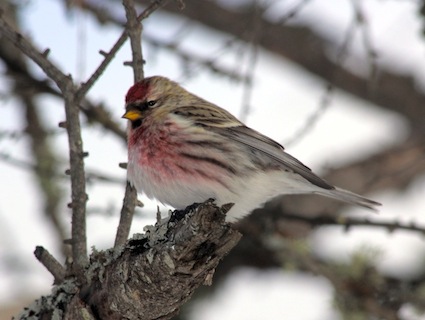
Redpoll picture by Laura Erickson Flickr
Arin has seen several large flocks of Redpolls at her feeder this winter. She found out that they are usually found in the arctic north but as food supplies get low up there, they travel south looking for food. She said that when they come for a visit her bird feeder empties quickly!
Redpolls travel in flocks of up to several hundred individuals! They move frenetically, foraging on seeds in weedy fields or small trees one minute and swirling away in a mass of chattering birds the next. Their buzzy zap and rising "dreeee" calls are distinctive. Look for them feeding on catkins in birch trees or visiting feeders in winter. These small finches of the arctic tundra and boreal forest migrate erratically, and they occasionally show up in large numbers as far south as the central U.S. During such irruption years, redpolls often congregate at bird feeders (particularly thistle or nyjer seed), allowing delightfully close looks.
Common Redpolls are small songbirds with small heads and small, pointed, seed-eating bills. The tail is short with a small notch at the tip. They are brown and white birds with heavily streaked sides. Look for a small red forehead patch, black feathering around a yellow bill, and two white wingbars. Males have a pale red vest on the chest and upper flanks.
• Common Redpolls can survive temperatures of –65 degrees Fahrenheit. A study in Alaska found Redpolls put on about 31 percent more plumage by weight in November than they did in July.
• During winter, some Common Redpolls tunnel into the snow to stay warm during the night. Tunnels may be more than a foot long and 4 inches under the insulating snow.
• Redpolls have throat pouches for temporarily storing seeds. They may fill their pouches with seeds quickly then fly away to swallow the seeds in a more protected, warmer spot.
• A few banding records have shown that some Common Redpolls are incredibly wide ranging. Among them, a bird banded in Michigan was recovered in Siberia; others in Alaska have been recovered in the eastern U.S., and a redpoll banded in Belgium was found 2 years later in China.
Keep an eye out for these pretty little birds!
Information found at:
Cornell University's All About Birds
To view yearly archives of our "New In
Nature" series click on year you wish to see.
2002
2003
2004
2005
2006
2007
2008
2009
2010
2011
2012
|


